I had booked a trip to Panama, for what would be my first visit to Central America. Panama is blessed with being one of the most bio-diverse countries on the planet. For me, seeing her iconic sloth was near the top of my wildlife wish list. From what I had read, seeing a sloth would be straight forward. I half expected to see one hanging in the first tree outside the airport door, but it wasn’t quite that easy. I had been traveling around Panama for over a week without so much as a rumour of a sloth, when I arrived on the steamy emerald island of Bastimentos.
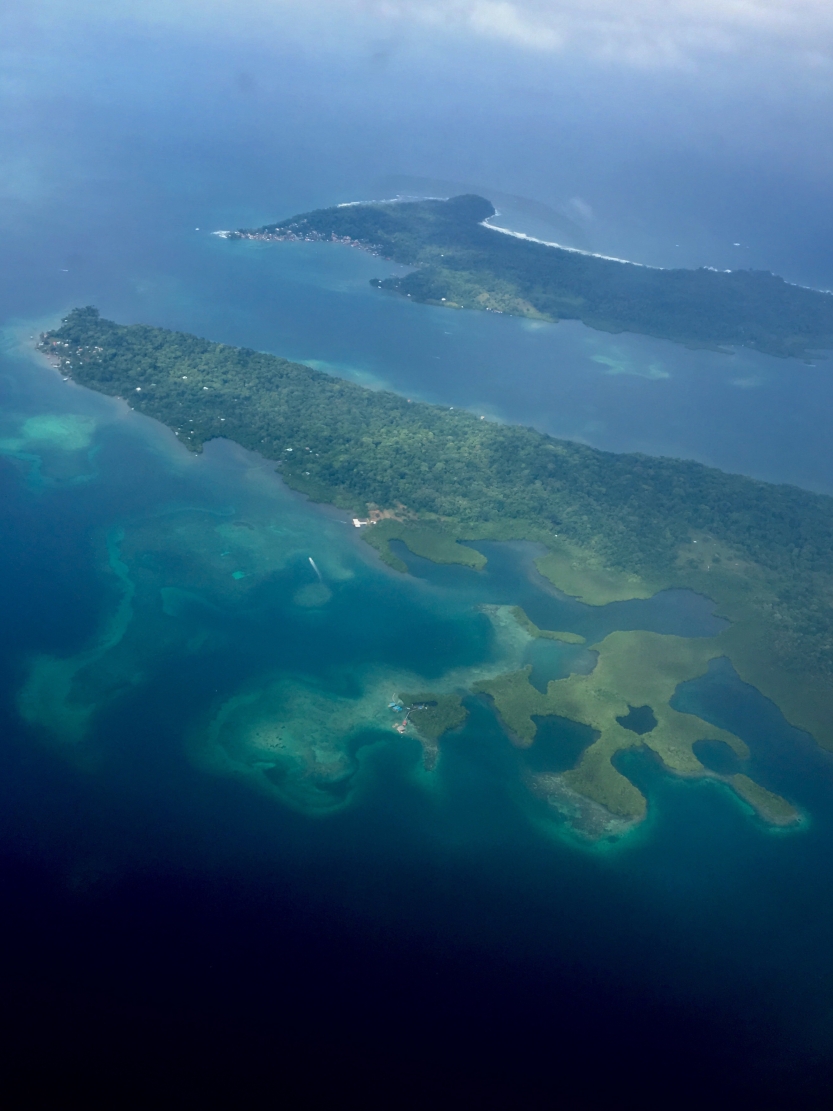
A few days passed with no progress, although I did meet someone who had seen a sloth near the beach house where we were staying. I took a stroll along the beach to the nearby eco-lodge, to arrange a boat trip for the following morning. Arriving at the lodge, I peered up into the branches of a fruiting tree, where I could make out a small wire-haired bundle. It couldn’t be, could it? There was no movement, no face, and no toes on show, but this was clearly the bottom end of a Brown-throated Three-toed Sloth.
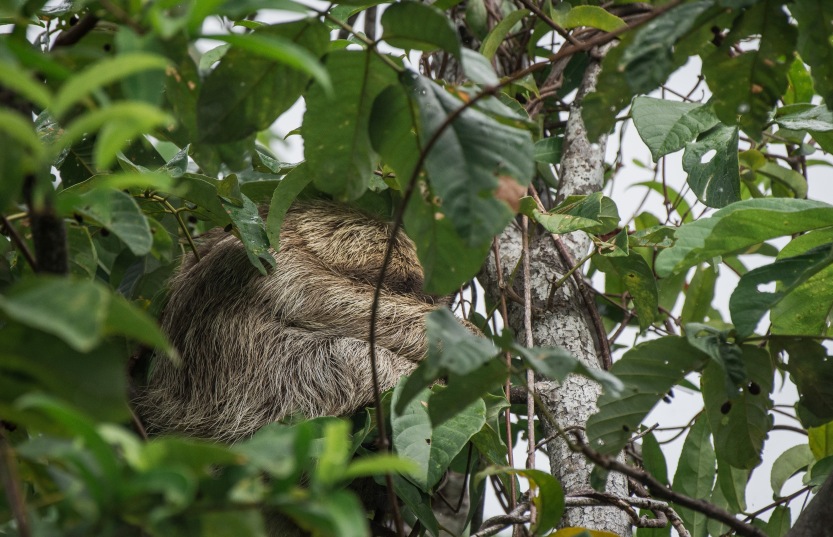
I had imagined a bigger animal than the small shaggy ball that was huddled in the branches above. I hung around waiting for a photo opportunity but this sloth was very much asleep. A sloth can sleep for 14 hours a day, so waiting it out was not an option.
The following morning our footsteps sent thumb-nail hermit crabs scurrying for cover as we crunched towards the boat dock. We clambered into a narrow dugout canoe and chugged through mangrove avenue, where root claws lay the course to the Salt Creek indigenous community. After discussions with community members we chose to take an easy trail, as we would be hiking with my 4-year-old son. An ingenious coconut shell path kept our feet from sinking in mud as it carried us into the stifling rainforest. We hadn’t been walking for long when we spotted a sloth. Once again it presented me with a wire-haired backside as it slept. I was starting to think that this would be the extent of my sloth photography opportunities. We walked on through rainforest that was bursting with wildlife. Excited, exhausted and with a couple of SD cards filled with photographs, we returned along the same path that had taken us into the jungle. There we found our sloth from earlier in the day, but now it was awake and searching for a leafy lunch.
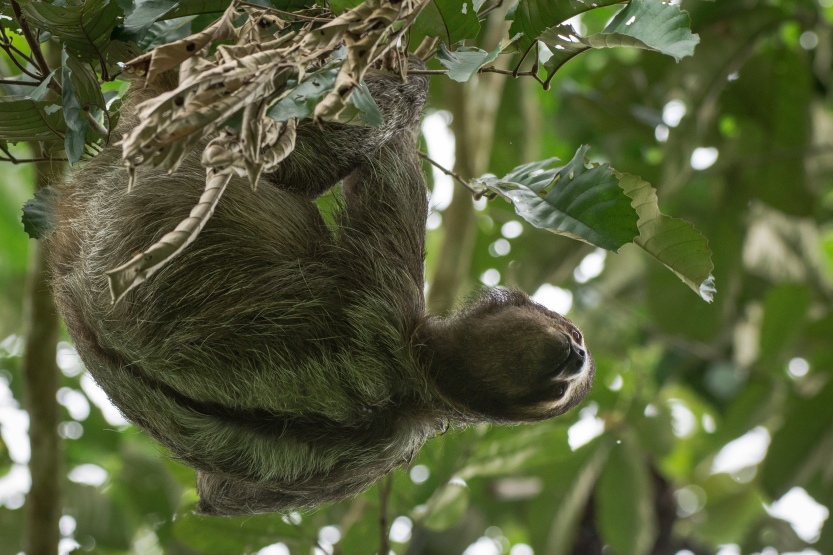
The sloth had crawled down to some low branches where it hung not far from my head. I had been photographing poison dart frogs and had left the macro lens on my camera. A panicked fumble ensued, which resulted in my lens-less camera body falling to the sodden ground. I grabbed up the muddy black box, rubbed it down with my shirt, fitted a lens and in no time, I was firing shots.
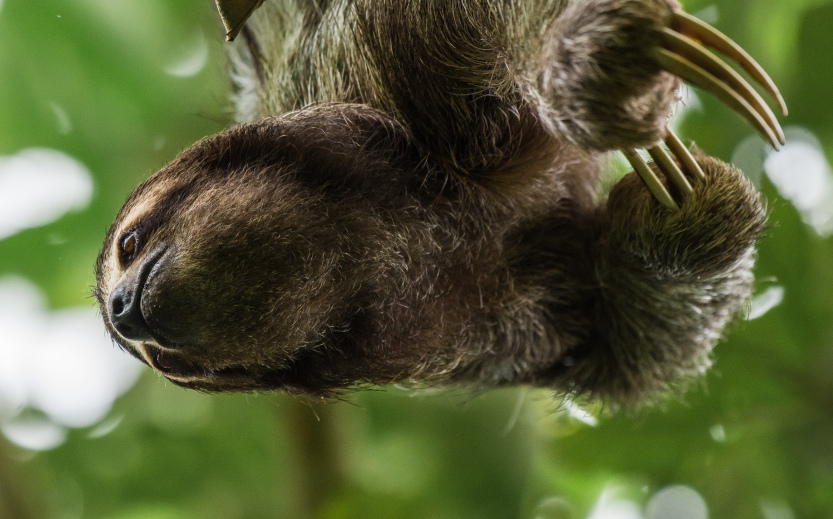
When I’m taking wildlife photographs I try to find a balance of getting the shots that I want but also being there in the moment, enjoying the experience. I always take some time to see the animal with my eyes rather than through lens glass. I was enchanted by the life that sparkled from two chestnut eyes. The world’s slowest mammal was not as slow as I was expecting, as it dragged itself through the branches with its long, out of proportion arms. I was astonished by the claws! The three toes (that are actually fingers) put Edward Scissor hands to shame!
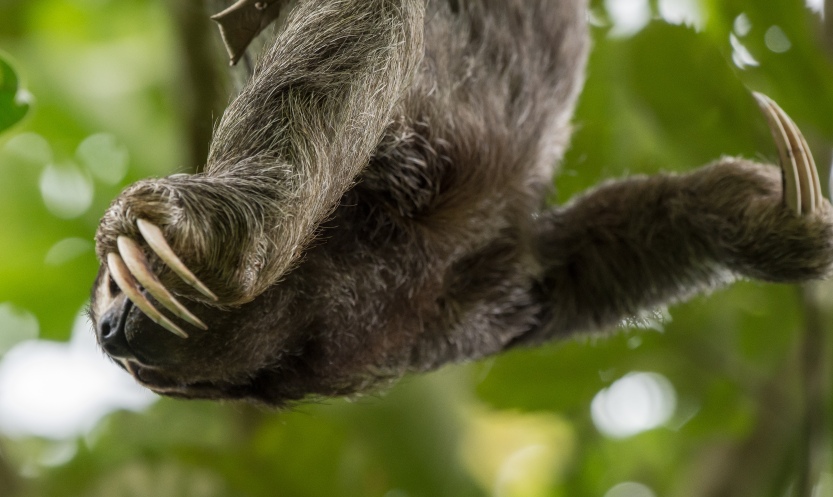
The three-toed sloth grows up to 58 cm (23 inches) and can weigh up to 3.9 kg (8.75 pounds). It spends almost its entire life in the treetops, coming down just once a week to defecate. Amazingly the shaggy coat of the sloth has become home to a species of moth that lives only on sloths. When the sloth comes down to answer nature’s call the Sloth Moth hops off, lays eggs on the poo and hops back on again for the slow ascent into the canopy.
The male Three-toed sloth develops a colourful center parting, called a speculum, on his back when he reaches sexual maturity. This patch of butter, brown and black fur gives each male sloth a unique identifying mark, that would not look out of place on one of the big cat family. It surely has a role to play in courtship, but it seems a little out of place on such a well camouflaged animal.
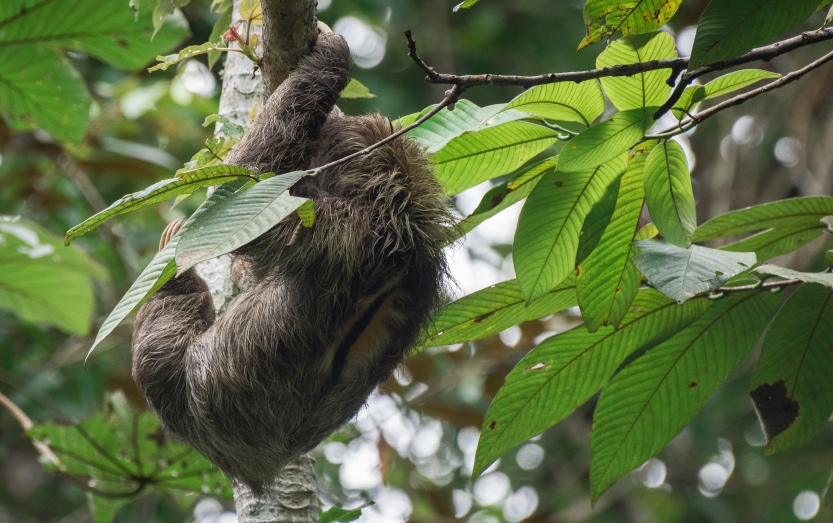
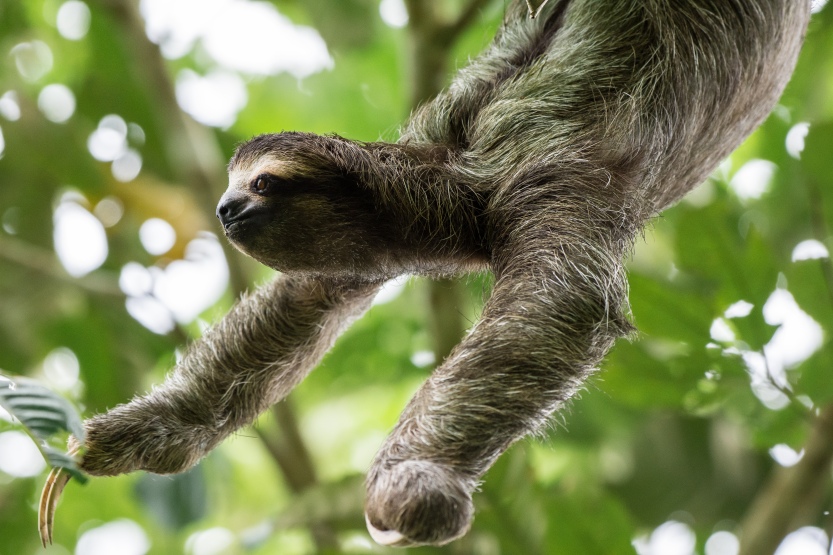
The sloth treated us to an extraordinary close-up encounter. After a while, having decided that there were no more good leaves below, it turned and steadily made its way back up the tree, presenting me with that usual sloth view; a fuzzy butt.
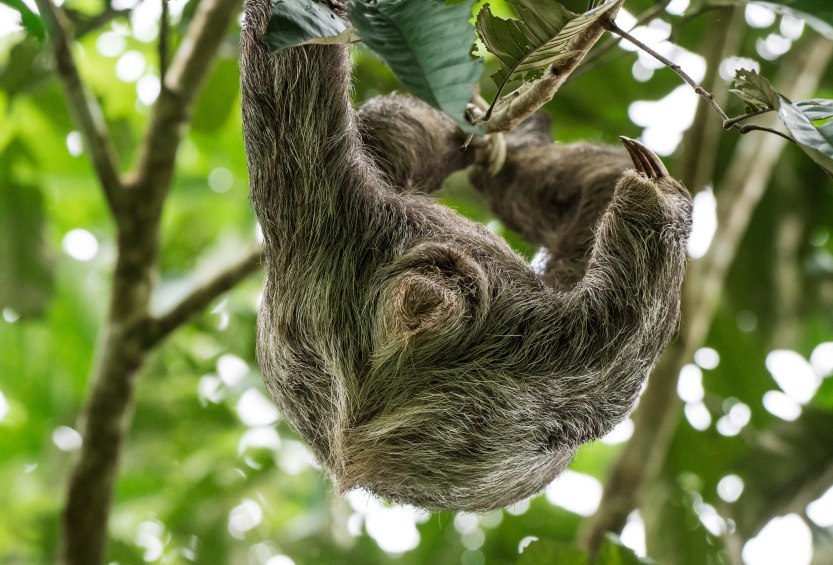
Later that afternoon, back at the beach, I was in the ‘lounge room’ above the eco-lodge restaurant. From the vantage point of this open sided, thatched platform, I spotted the sloth from the previous day, but this time she was very much awake and searching for dinner. She skillfully navigated the thin canopy branches with a dexterity not normally associated with the word sloth. While I was firing shots, I noticed an unusual disturbance in the fur on her belly. I zoomed in tight and then zoomed the photo that I had taken. Sure enough, clinging tightly to her belly fur was a tiny teddy bear baby sloth.
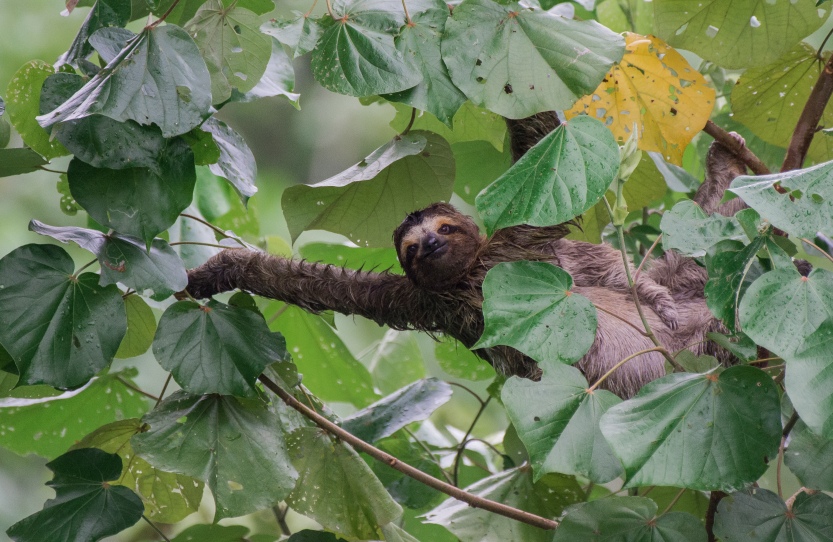

The final sloth of the trip was hanging around in a roadside tree, on the outskirts of Panama City. We pulled over and I jumped out of the car for one last look. The pretty male sloth was on the move, showing the three toes on the hind legs that are common to all sloths, as well as the three fingers on the front leg that distinguish the species. There have been moves to rename sloths based on fingers rather than the existing toe based classification. I felt like I could have stayed with him all day, but I knew he would soon return to being that sleeping ball of wire wool.

The end of the holiday had arrived and my desire to see a sloth had been satisfied beyond my hopes. My young son had also been delighted by the inspiring experience of getting close to these unique animals. By the time I left Panama I had seen, and photographed several Three-toed sloths and even a couple of their less common Two-toed cousins. We will hear more about them in a future article.
Happily, the three-toed sloth is listed as having a conservation status of Least Concern. If we can maintain healthy rainforests through sustainable logging practices, and establish land protected from development, then we can enjoy the slow and steady company of these beautiful animals for decades to come.
Further Reading – If you have an interest in sloths then I can’t recommend Sloths – Life In The Slow Lane highly enough. The book is written by Rebecca Cliffe and includes wonderful photography by the talented Suzi Esterhaz. Best of all, a significant amount of the proceeds from book sales goes straight back to the Sloth Conservation Foundation.
👇👇👇
Join the conversation below. Have you encountered a sloth? Where did you see them?
Connect others with wildlife by sharing this post on social media and, if you enjoyed this post, please follow Incidental Naturalist.
Categories: Central America
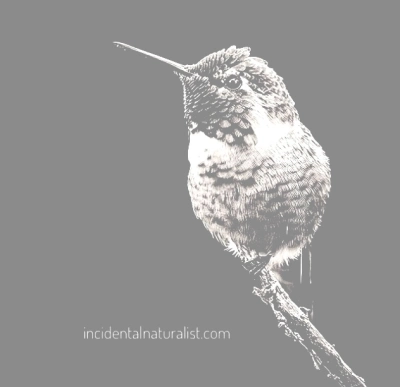


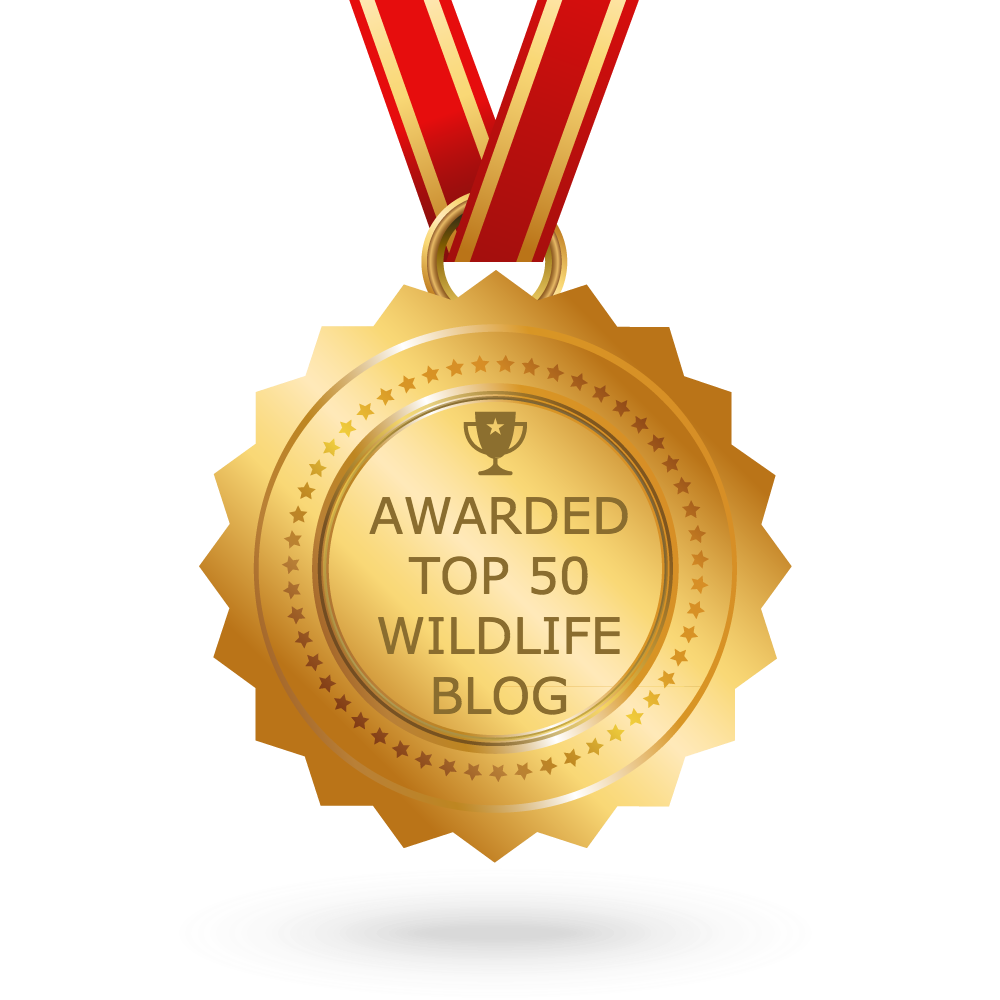

Great post! I am so jealous that you got to see these wonderful creatures in their natural habitat. Especially that you got to see a mum and her baby! I think I was a sloth in my previous life …. if I could sleep about 14 hours a day that would be awesome lol.
LikeLiked by 4 people
I think that many of us have a little bit of sloth in our genes somewhere. I’d settle for 10 hours of zzzzzs 🙂
LikeLiked by 1 person
OMG how amazing!!! And to see the baby! Great story David. At some point I’d also love to see the poison dart frog photos too 🙂
LikeLiked by 3 people
Thank you, Kerri! It was an amazing experience. Here is my post about the Green & Black poison dart frogs. I’ll probably post the Strawberry poison darts next month 🙂
https://incidentalnaturalist.com/2018/02/07/pint-sized-poisoner-green-black-poison-dart-frog/
LikeLike
YAY! I’m so happy for you — what an incredible experience, and how wonderful that you were able to share it with your son. You also got some FANTASTIC photos, David! Thank you for sharing them, along with what you learned about these fascinating creatures.
LikeLiked by 3 people
Thank you for the kind words, Heide! My son has seen some extraordinary wildlife. It is such a pleasure to show him creatures like this. He now has a toy sloth hanging around in his room. I hadn’t even heard of a sloth at that age! 🙂
LikeLiked by 1 person
Oh I so enjoyed this post. I felt your horror at dropping your camera body in the mud (yikes!) and your joy and excitement at seeing the sloths. I saw a few in the jungle when we were in the Amazon in Peru, but never such a close-up encounter as you had. And spotting that baby – how exciting! Did you know sloths can swim? There’s a section about sloths in the first episode of Planet Earth II.
Alison
LikeLiked by 2 people
Hi Alison, I’m glad that you enjoyed the post. It is never good to drop your camera, especially when there is a sloth above your head! 😊 I saw that episode of Planet Earth II and was stunned to see a swimming sloth. Suzi Eszterhas photographed swimming sloths for the book that I mention at the end of the article. Apparently she had to practice the photography technique in a swimming pool with a teddy bear! 😊
LikeLiked by 2 people
Wow, David what an exciting experience! Thanks also for the wonderful photos of these interesting creatures!
LikeLiked by 1 person
I see that Panama didn’t disappoint! It seems like many of your wildlife sightings happen “by accident” when you’re not actually looking for them.
LikeLiked by 1 person
Hi Josh, Panama really did not disappoint, I’ve already posted few creatures from my trip and I have many more to share. There is such biodiversity and the wildlife is so accessible. I definitely recommend Panama to any wildlife enthusiast. Some of my best wildlife sightings have been by accident, or as I like to say ‘incidental’. 😊
LikeLiked by 1 person
Great sloth photos! So cool that you caught one of a baby sloth on Mom. We saw some sloths in Costa Rica, but not anything as close as your encounters.
LikeLiked by 2 people
Thanks! 😊 Yeah, I was really fortunate to find the little one with mum. I certainly recommend Panama. I think the wildlife is much the same a Costa Rica but its proximity to the city makes it so accessible.
LikeLiked by 1 person
I vaguely recall our visit there in the 1970s. Time for a return trip!
LikeLiked by 1 person
Thanks for the ongoing education via word and photo, Davdi! I sent this post on to a friend who loves sloths “) Spread the word!
LikeLiked by 2 people
Thanks Lara! 😊 I hope your friend enjoys the post. The book that I mention at the end is great for sloth lovers! Thank you for helping to spread the word and connect people with Mother Nature’s treasures. 😊
LikeLiked by 1 person
Pleasure, David “) Grateful for your blog!
LikeLiked by 1 person
So glad you got to have this wonderful experience, and your photographs turned out amazing!
LikeLiked by 3 people
Thank you for the kind words, Laura! Panama is a wonderful place for wildlife lovers. Especially those with a camera! 😊
LikeLiked by 2 people
If only I could be on permanent vacation in Central America… I would be the happiest wildlife lover in the world then!
LikeLiked by 2 people
Once again, you got some dynamite shots and I really enjoy your story-telling. More! More!
LikeLiked by 2 people
Thank you, Tara! 🙏I have plenty more to come! 😊
LikeLiked by 1 person
I hope so.
LikeLiked by 1 person
I always thought that sloths spend most of their days sleeping. But apparently cats can sleep longer than their slower, tree-hugging mammal counterparts. I really enjoyed this post, David, and when it comes to the part when you dropped your camera body, oh well, my clumsy self can imagine that kind of situation. But at least you got some amazing shots of the sloths!
LikeLiked by 2 people
Thanks for the comment! Interesting that cats sleep for longer than sloths. I guess they expend a little more energy when they are awake. 😊 I was fortunate that the camera somehow didn’t get mud inside. That was a miracle!
LikeLiked by 2 people
Wonderful! My parents are going to Costa Rica next month to see sloths — I hope to go myself one day. Interesting that they’re weren’t as big as you’d imagined. I’d always kind of pictured them about the size of a vervet monkey. Maybe just a tad longer in body. How do they compare?
LikeLiked by 2 people
I’d like to get to Costa Rica someday soon. The Wildlife is much the same as Panamá but I want to see Macaws. I hope your parents see their sloth. If not, send them to Panamá city; they are guaranteed to see one there. 😊 I think they might be slightly smaller than a vervet monkey, or maybe it just seems like that because of their odd shape. No tail and super long arms. The body is probably around the same size.
LikeLiked by 2 people
Sloths are amazing!
Thanks for sharing your gorgeous pics and your three toed sloth adventures. Hanging out with sloths, other than my teenage children, is definitely on my bucket list.
LikeLiked by 3 people
Thanks for the encouraging comment! 🙂 I hope you get a chance to meet these guys in their natural habitat.
LikeLiked by 1 person
Sloths are my favorite animal. I can only imagine how exhilarating it must have been coming across these guys. You have wonderful pictures! I might have to book a trip to Panama now!
LikeLiked by 3 people
Thank you so much! If you love wildlife, or even just like birds, then Panama is a really great spot. You can see so many exotic species within a few minutes’ drive of Panama City.
LikeLiked by 2 people
I love the way you write .. haha you bring to life your scenery and i can totally picture it! How cool is they to see the red frog from your childhood and to see an actual sloth! I always picture them moving super crazy slow lol but i’m sure as you mentioned .. they are quicker than expected. I believe its because he was in his homefront. 😊 Still a very inspiring experiance.
LikeLike
Thank you, Jenn! 🙏 very encouraging words. Yes it was amazing to see sloths and red frogs all in a fairly short walk. Panamá is fantastic for wildlife! 😊
LikeLiked by 2 people
Great writing depth and correlating images. Thanks for teaching.
LikeLiked by 2 people
Thank you! 🙏 I like the look of your blog. I’ve got to follow that journey! 😁
LikeLiked by 1 person